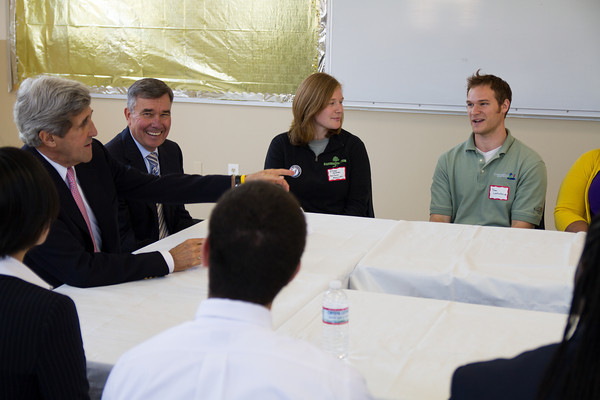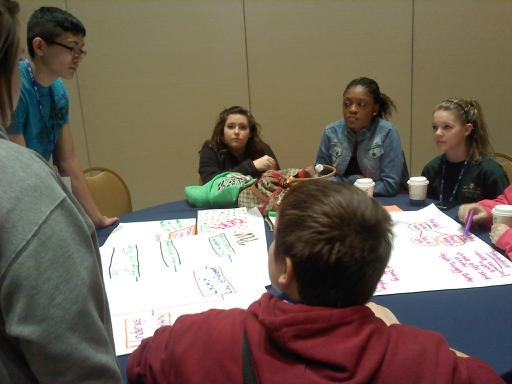ONDCP Blog
Visiting Boston: Inspiration at Roca Inc.
Posted by on May 7, 2012 at 4:41 PM EDTToday I was in Boston for an event with Senator John Kerry to highlight the issue of prescription drug and heroin abuse and discuss what we can do to keep our communities healthy and safe. While I was there, I was heartened to learn that Blue Cross Blue Shield of Massachusetts will soon institute a new policy to help decrease prescription drug abuse. The steps taken by Blue Cross/Blue Shield demonstrate that everyone, including insurers, have a role to play in addressing the rising tide of prescription drug abuse.
Untreated substance use disorders and drug abuse touch everyone. Theystrain our economy, our healthcare and criminal justice systems, and endanger the future of our young people. When I look at the challenges facing America’s youth today, who are competing an increasingly globalized, changing economy, I know that America cannot reach its full potential unless our youngest generation is healthy and drug-free.
As part of my visit to Boston, I also had the chance to hear from youth involved in Roca Inc. Roca is a local organization whose mission is to help break the cycle of violence and poverty by giving young people a better shot at a brighter future.

Photo: Senator Kerry and Director Kerlikowske speak with AmeriCorps/City Year participants.
Inspirational people like those I met today at Roca are vital to our efforts to reduce drug abuse. We know that drug education works to prevent abuse and to empower young people to help educate their peers. I applaud Roca for its groundbreaking work in creating a better, brighter future for high-risk youth and I look forward to keeping up with their progress in the years to come.

Photo: Senator Kerry and Director Kerlikowske pose youth forum participants at Roca Inc.
To learn more about Roca Inc., read about its mission here. To see the Administration’s 21st century approach to drug policy, read the 2012 National Drug Control Strategy. For more information on national efforts to reduce drug use and its consequences, visit our website at www.WhiteHouse.gov/ONDCP.
Learn more aboutTeaming Up With Kent County Prevention Coalition for Above the Influence Youth Summit
Posted by on May 4, 2012 at 4:47 PM EDTOn April 27th, we teamed up with the Kent County Prevention Coalition (KCPC) for the first ever Kent County Above the Influence (ATI) “Live Out Loud: Dream IT, Believe IT, Achieve IT” Youth Summit. This two-day summit brought together more than 650 middle and high school students from across the Kent County, Michigan, area to engage youth in dialogue about negative influences, including drugs and alcohol.
During the summit, youth joined group discussions and activities designed to challenge them to think critically about the pressures they face to use drugs and alcohol. We were pleased to have the opportunity to present an award to one of the students in attendance, Thalia Vega, who participated in the summit’s “Be It” challenge. Thalia’s slogan, “Let your heart do the speaking,” has been copied on billboards throughout the Grand Rapids area and exemplifies the creativity local and community partners put into the Above the Influence campaign.

Deputy Director of State, Local, and Tribal Affairs Benjamin Tucker, provided remarks and welcomed conference attendees. Deputy Director Tucker was also featured on ABC’s WZZM 13in Grand Rapids, PBS’s WGVU Radio, CBS’s WWMT, Mlive, and Fox 17.
In the words of Shannon Cohen, Coordinator of the Kent County Prevention Coalition, “This conference really gotour youth excited about making positive choices. This isn’t your grandfather’s typical ‘drugs are bad!’ lecture; it’s about giving teens something to walk away with on a more personal level.” To learn more about the Above the Influence campaign and partners, please visit www.ATIPartnerships.com.
Learn more about276 Tons of Rx Pills Collected at National Prescription Drug Take-Back Day
Posted by on May 3, 2012 at 6:49 PM EDTOn April 28th, the fourth annual National Prescription Drug Take-Back Day, the DEA and its partners around the country collected 552,161 pounds—276 tons—of unneeded prescription medication. This initiative is an important piece of our strategy to decrease prescription drug abuse, especially in light of our recent data analysis showing new Rx drug abusers are more likely to get their drugs from friends or family.
Volunteers at two of the 5,659 take-back sites across the country were visited by senior leaders from our office. In Washington State for official travel, Director Kerlikowske stopped by a collection site in Des Moines, WA, where residents dropped off more than 290 pounds of unneeded prescription drugs.

Back in D.C., David Mineta, our Deputy Director of Demand Reduction, showed his support with volunteers at Bolling Air Force Base.

We applaud everyone who made last Saturday such an overwhelming success, bringing the four-year total of collected medication to 1.5 million pounds, and we look forward to marking a new record next year.
Learn more aboutSummer Jobs+: The Pulaski Community Partners Coalition Youth Training Center
Posted by on May 3, 2012 at 5:24 PM EDT"America's young people face record unemployment, and we need to do everything we can to make sure they've got the opportunity to earn the skills and a work ethic that come with a job. It's important for their future, and for America's…That's why today, we're launching Summer Jobs+, a joint initiative that challenges business leaders and communities to join my Administration in providing hundreds of thousands of summer jobs for America's youth"
—President Obama
As the White House and Department of Labor kick off the Summer Jobs+ program with the announcement of some innovative smartphone apps to assist in the job search, we’d like to highlight the work our Drug Free Communities grantees are doing to help young people find jobs.
After the Pulaski Community Partners Coalition (PCPC) in Pulaski, Virginia, became a Drug Free Communities grantee, members found that joblessness was contributing to a sense of hopelessness in the area, which in turn greatly increased substance abuse in all ages. Businesses in the area also had difficulty finding a skilled, drug-free work force.
PCPC set out to build a skilled, drug-free workforce by giving youth the experience necessary to help them to visualize a successful future without alcohol and drugs. To do this, PCPC developed a “Youth Training Center” (YTC) program, which they will pilot this summer. The pilot program will target 14- to 18-year-olds and those that successfully complete the program will receive a stipend.
The YTC program has two parts: classroom training and hands-on work experience.
The program teaches soft skills like resume writing, filling out job applications, interviewing, appropriate dress and body language. The youth participants will be trained in how to take initiative in the workplace. Program staff will discuss the impact substance abuse can have both on current employment and future prospects. Then, the youth will put their skills to work in a safe, supervised job setting.

The program has partnered with various businesses and organizations including: the Pulaski County Juvenile Court Services, the Chamber of Commerce, the YMCA, the Pulaski Police Department, the Pulaski Library, and the Department of Business at Virginia Tech. These partners will provide training and employment opportunities to youth involved in the program.
ONDCP applauds PCPC for their efforts to create and train a young, drug-free workforce for the future of their community and looks forward to the success of the program in the coming years.
Learn more aboutNational Study: “Heavy” Marijuana Use Up 80 Percent Among Teens
Posted by on May 2, 2012 at 5:08 PM EDTToday, our colleagues at The Partnership at Drugfree.org released the findings of a new, national study called The Partnership Attitude Tracking Study, or PATS. This study tracks drug use and attitude trends among high-school aged teens in America, and this year it revealed some troubling findings.
Most notably, it found that marijuana use among teens in 2011 rose over the preceding three years, with an especially sharp rise in past-month, heavy use (i.e., 20 or more times in the past 30 days) of the drug. Heavy, past-month use of marijuana saw an 80 percent increase among U.S. teens since 2008. These findings draw particular attention to the huge gap in youth education left behind when the National Youth Anti-Drug Media Campaignwas defunded by Congress last year.
As the Partnership notes, the last time marijuana use was this widespread among teens was in 1998 when past-month use of marijuana was at 27 percent. Marijuana use by teens is up across the board, with a 42 percent increase in past-month use, a 26 percent increase in past-year use, and a 21 percent increase in lifetime use.
Marijuana use has become a normalized behavior among American teens; in the study, 30 percent fewer teens agreed with the statement “in my school, most teens don’t smoke marijuana” than in 2008. 71 percent of teens say they have friends who use marijuana regularly (up from 64 percent in 2008).
With heavy marijuana use up 80 percent in 2011, Steve Pasierb, President and CEO of The Partnership at Drugfree.org, expressed concern about the risks of teenage drug use—which has been shown to lead to substance abuse disorders in adulthood.
From The Partnership at Drugfree.org: "These findings are deeply disturbing as the increases we're seeing in heavy, regular marijuana use among high school students can spell real trouble for these teens later on,” said Steve Pasierb, President and CEO of The Partnership at Drugfree.org. “Heavy use of marijuana – particularly beginning in adolescence – brings the risk of serious problems and our data show it is linked to involvement with alcohol and other drugs as well. Kids who begin using drugs or alcohol as teenagers are more likely to struggle with substance use disorders when compared to those who start using after the teenage years.”
The study found that while the amount of prescription drug abuse among teens was relatively unchanged, the level was unacceptably high. Unfortunately this flattening effect cannot be attributed to parents included in the study, who reported that Rx medicines were actually more accessible in the home now than in 2010.
All of these findings underscore the importance of reaching and educating youth—and their parents—about the long-term consequences of teenage drug use.
Parents, for resources on educating your children about drugs, please visit The Anti-Drug. Teens looking for support to resist drug use can visit Above the Influence.
Learn more aboutTake Action: Find a National Take-Back Day Site Near You
Posted by on April 27, 2012 at 5:22 PM EDTAmerica is facing an unprecedented drug abuse epidemic fueled by prescription medications found in homes across the country. According to the CDC, prescription drug overdoses claimed the lives of more than 15,500 Americans in 2009 – nearly four times the number of people who died from these drugs in 1999.
In 2010, about 2,100 young people per day abused prescription drugs for the first time, and the majority of these pills came from friends, family, or in the home. Teens aren’t the only ones abusing medication; in 2010, Americans began using prescription drugs for non-medical reasons at a rate of about 6,600 people per day.
With more people dying from drug-induced deaths than car accidents in America, it is vitally important that we do what is necessary to prevent drug abuse.
Three out of four prescription drug overdoses involve opioid pain relievers, and, as we mentioned earlier this week, more than 65 percent of people who abuse medication obtain the drugs—for free, or without asking—from friends or family. With prescription drug abuse now at epidemic levels, it is more important than ever to remove unused and or unwanted prescription drugs from your home.
Tomorrow, Saturday, April 28, Director Kerlikowske will participate in the fourth National Prescription Drug Take-Back Day, with scheduled visits to four collection locations in the Seattle area. For the event, organized by the Drug Enforcement Administration (DEA), collection sites around the country will allow residents to safely dispose of unneeded or unwanted prescription drugs in a cost-effective and environmentally responsible way.
Approximately 377,086 pounds of unwanted or expired medications were turned in at more than 5,000 sites during DEA’s most recent Take-Back event in October 2011. In all, state, local and tribal partners have collected nearly 500 tons of pills during Take-Back events in 2010 and 2011.
For more information about Take-Back Day, go here. To locate a take-back site near you, please use the DEA’s site locator. To learn more about the Administration’s strategy for combating prescription drug abuse, see the 2011 Prescription Drug Abuse Prevention Plan.
Learn more aboutFriends and Family are Primary Sources of Abused Prescription Drugs
Posted by on April 25, 2012 at 3:41 PM EDTOne year ago, the Administration released Epidemic: Responding to America's Prescription Drug Abuse Crisis, a national framework for reducing prescription drug abuse and diversion. This plan outlined action in four major areas to reduce prescription drug abuse:
- Education: supporting education for patients and healthcare providers;
- Tracking and monitoring: supporting the expansion of state-based prescription drug monitoring programs;
- Proper disposal: recommending more convenient and environmentally responsible disposal methods to remove unused medications from the home;
- Enforcement: reducing the prevalence of “pill mills” and “doctor shopping” through enforcement efforts.
Today, ONDCP released new data analysis revealing that the majority of first-time or occasional prescription drug abusers are most likely to get their drugs from a friend or family member-- for free, or without permission 1. Prescription drugs are the second-most abused category of drugs in the United States, following marijuana. When taken as directed for legitimate medical purposes, prescription drugs are safe and effective. However, they are just as dangerous and deadly as illegal drugs when used for non-medical reasons. This new analysis found that:
- Among new abusers of pain relievers (those who began misuse of pain relievers in the past year), 68 percent obtained the pills from a friend or relative for free or took them without asking, 17 percent got them through prescription by one or more doctors, and 9 percent purchased them from a friend, dealer, or the Internet.
- Among occasional abusers of pain relievers (less than once a week on average in the past year), 66 percent obtained the pills from a friend or relative for free or took them without asking, 17 percent got them through prescription from one or more doctors, and 13 percent purchased them from a friend or relative, dealer, or the Internet.
- Among chronic abusers of pain relievers, 41 percent obtained the pills from a friend or relative for free or without asking, 26 percent got them through prescription from one or more doctors, and 28 percent purchased them from a friend or relative, dealer, or the Internet.

These findings underscore the importance of one of the core elements of the Administration’s prescription drug abuse prevention plan: the proper disposal of unused medications. To help Americans dispose of any unneeded medications in their homes, the Drug Enforcement Administration will host its fourth National Take Back Day on Saturday, April 28th, at over 5,000 collection sites across the United States.
Last October, Americans disposed of 377,080 pounds—188.5 tons—of prescription drugs at over 5,300 sites operated by the DEA and nearly 4,000 state and local law enforcement partners. In its three previous Take Back events, DEA and its partners took in almost a million pounds—nearly 500 tons—of pills.
To find a collection site near you, visit the DEA’s site locator online. Additionally, the FDA provides guidelines on how consumers can properly dispose of unused medicines on their own here.
1 Source: Data averaged from the Substance Abuse and Mental Health Service Administration’s 2009 and 2010 National Survey on Drug Use and Health (NSDUH).
Learn more aboutThe National Drug Control Strategy: From “Rethinking” to Reform
Posted by on April 23, 2012 at 5:39 PM EDTIn a recent Saturday Essay in the Wall Street Journal, drug policy experts Mark A. R. Kleiman, Jonathan P. Caulkins, and Angela Hawken note that the problem of drug abuse and addiction does not lend itself to simple solutions: neither an enforcement-centric “war on drugs” nor the simple notion of drug legalization provide the answer to this complex public health and safety problem. Rather, the authors point out that innovative criminal justice programs and policy reforms—backed by evidence—hold great promise for reducing drug use and its consequences in the United States.
I am pleased to see innovative ideas for addressing our country’s drug problem gaining traction in a public debate that is increasingly dominated by extremes. Just last Tuesday I released the Obama Administration’s 2012 National Drug Control Strategy, which serves as the Nation's blueprint for reducing drug use and its consequences. The new Strategy provides a review of the progress we have made over the past 3 years and looks ahead to our continuing efforts to reform, rebalance, and renew our national drug control policy to address the public health and safety challenges of the 21st century. Since the publication of the Administration’s inaugural National Drug Control Strategy in 2010, the annual Strategy has been incorporating much of the research cited by the essay’s authors and turning it into action.
For example, the authors cite the promising results first achieved by Judge Steve Alm of Hawaii through the use of an enhanced probation program (Project HOPE) that employs drug testing and swift, certain—but moderate—sanctions for detected drug use. As part of the National Drug Control Strategy, the U.S. Department of Justice’s Bureau of Justice Assistance (BJA) is funding a demonstration field experiment to test this approach in four new jurisdictions that vary widely in demographics, population, density, and geographic location—Clackamas County, OR; Essex County, MA; Saline County, AR; and Tarrant County, TX (the probation chief for Tarrant County, Leighton Iles, was quoted in the Wall Street Journal essay). The National Institute of Justice will be conducting an evaluation of this project.
In addition, the essay highlights the Drug Market Intervention program, which reduces drug dealing and related violence by creating clear and predictable sanctions, offering a range of community services, establishing community standards for acceptable behavior, and improving community-police relations through direct engagement among law enforcement, prosecutors, drug dealers, their families, and communities.The 2012 National Drug Control Strategy includes support for technical assistance and program evaluation in communities that are implementing the Drug Market Intervention program.
These are just two examples of the Strategy’s criminal justice reform efforts, which also include support for drug treatment courts, sentencing reform, institutional change initiatives, evidence-based community supervision and reentry programs, and efforts to eliminate legal and regulatory barriers facing individuals in recovery from substance use disorders.
More information on the criminal justice reform efforts included in the National Drug Control Strategy can be found here.
R. Gil Kerlikowske is Director of National Drug Control Policy
Learn more aboutAddressing Drug Use and Its Consequences in the Latino Community
Posted by on April 20, 2012 at 6:00 PM EDTToday, I had the privilege to join California Congresswoman Lucille Roybal-Allard to discuss our Nation’s drug problem and explore ways we can work together to improve public health and safety in the Los Angeles area.
Drug abuse affects every demographic group in America. However, data show in some ways, it disproportionately affects Latino communities. In fact, between 2008 and 2009, we saw a 39 percent increase in drug use among male Latino teens. Additionally, another recent poll found that Hispanic parents now ranked drug abuse as the number-one health issue facing children in their communities.
During my visit I stressed how important prevention can be. This is where parents and adult influencers can play a critical role in raising healthy children. Research continues to show the most powerful force in the lives of young people are their parents, and the Obama Administration stands ready to provide families with the tools they need to protect young people. We’ve even put together Spanish language material at www.LaAntiDroga.com with tips on how to talk to teens and science-based information on drug use and its consequences.
I thoroughly enjoyed meeting with L.A. Latino community members today, and I look forward to continuing our work together to reduce the burden of drug use on Latino communities.
R. Gil Kerlikowske is Director of National Drug Control Policy
Learn more aboutA Drug Policy for the 21st Century
Posted by on April 17, 2012 at 12:18 PM EDTEd. Note: The following is a cross-post that originally appeared on the White House blog.
Illegal drugs not only harm a user’s mind and body, they devastate families, communities, and neighborhoods. They jeopardize public safety, prevent too many Americans from reaching their full potential, and place obstacles in the way of raising a healthy generation of young people.
To address these challenges, today we are releasing the 2012 National Drug Control Strategy—the Obama Administration’s primary policy blueprint for reducing drug use and its consequences in America. The President’s inaugural National Drug Control Strategy, published in 2010, charted a new direction in our approach to drug policy. Today’s Strategy builds upon that approach, which is based on science, evidence, and compassion. Most important, it is based on the premise that drug addiction is a chronic disease of the brain that can be prevented and treated. Simply put, we are not powerless against the challenge of substance abuse – people can recover, and millions are in recovery. These individuals are our neighbors, friends and family members. They contribute to our communities, our workforce, our economy, and help make America stronger.
Our emphasis on addressing the drug problem through a public health approach is grounded in decades of research and scientific study. There is overwhelming evidence that drug prevention and treatment programs achieve meaningful results with significant long-term cost savings. In fact, recent research has shown that each dollar invested in an evidence-based prevention program can reduce costs related to substance use disorders by an average of $18.
But reducing the burden of our Nation’s drug problem stretches beyond prevention and treatment. We need an all of the above approach. To address this problem in a comprehensive way, the President’s new Strategy also applies the principles of public health to reforming the criminal justice system, which continues to play a vital role in drug policy. It outlines ways to break the cycle of drug use, crime, incarceration, and arrest by diverting non-violent drug offenders into treatment, bolstering support for reentry programs that help offenders rejoin their communities, and advancing support for innovative enforcement programs proven to improve public health while protecting public safety.
Together, we have achieved significant reform in the way we address substance abuse. And the Affordable Care Act will—for the first time—require insurers to cover treatment for drug addiction the same way they would other chronic diseases. This is a revolutionary shift in how we address drug policy in America.
Over the past three decades, we have reduced illegal drug use in America. Over the long term, rates of drug use among young people today are far lower than they were 30 years ago. More recently cocaine use has dropped nearly 40 percent and meth use has dropped by half. And we can do more. As President Obama has noted, we have successfully changed attitudes regarding rates of smoking and drunk driving and with your help we can do the same with our illegal drug problem.
- Click here to see videos and read more about innovative new alternatives to drug control supported by the Obama Administration
- Click here to download the infographic: “Obama Administration Drug Policy: A Record of Reform”
A full copy of the 2012 National Drug Control Strategy is available here.
Kathleen Sebelius is the Secretary of Health and Human Services; Eric Holder is the U.S. Attorney General; and Gil Kerlikowske is the Director of the White House Office of National Drug Control Policy
Learn more about
- &lsaquo previous
- …
- 16
- 17
- 18
- 19
- 20
- 21
- 22
- 23
- 24
- …
- next &rsaquo